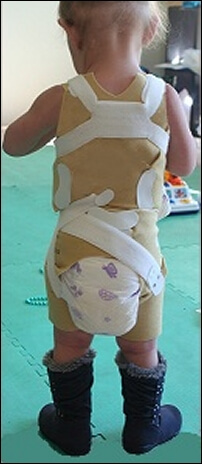Hemiplegic CP
Hemiplegia is a complex disorder that is compounded by the child’s ability to find strategies using the less affected extremities that compensate for the difficulties encountered on the affected side. The result is a progressive deterioration of function, size, muscle extensibility, and use-related bone growth and formation in the limbs on the affected side.
How TheraTogs Can Help
TheraTogs systems can support therapy goals by:
-
Improving body symmetry and weight loading on the affected side
-
Enhancing functioning stability of the trunk and the affected hip, and scapula
-
Fostering effective use of the affected limbs by improving postural control and proximal limb joint alignment – including increasing affected step length by reducing consistent pelvic rotation toward the affected side.
-
Minimizing soft tissue and bone deformities related to asymmetric alignment and weight-loading.
Which TheraTogs Systems to Use
These TheraTogs products support therapy goals for children with hypotonia:
-
Full Body System (FBS) – comes with limb strapping components.
-
Wunzi System – for infants and young preschoolers.
Applicable Science, and Therapy Approaches
Sciences that apply to the management of hemiplegic CP:
- Biomechanics
- Kinesiology
- Physiologic adaptation of bone and soft tissues to use history
- Postural control
- Somatosensory information processing and modulation
- Neural plasticity: cortical mapping and massed practice
Therapy approaches that can be used to address hemiplegic CP:
More About Hemiplegic CP

Though the causes of hemiplegic CP are varied, a prenatal or perinatal (birth-period) stroke due to arterial ischemia (blood flow blockage) is common.
The neurologic classification system lists three categories of hemiplegia:
-
Spastic (pyramidal) CP
-
Dyskinetic (extrapyramidal) CP
-
Mixed types
Pyramidal tract lesions are associated with an impaired ability to use muscles in a effective and efficient patterns (i.e. reduced selective motor control). Though the lesion is unchanging, muscle stiffness and joint deformities in the affected limbs usually worsen over time. Spasticity is present if a pyramidal tract lesion interferes with normal modulation of muscle stretch reflexes. Signs of spasticity include exaggerated reflex responses. Muscle stiffness can develop without, and is not evidence of, spasticity; spasticity cannot cause muscle stiffness.
Dyskinesia is characterized by the presence of involuntary movements or posturing.
Learn more about CP at CerebralPalsy.org and www.aacpdm.org.
References
Himmelmann K1, Hagberg G, Beckung E, Hagberg B, Uvebrant P. 2005. The changing panorama of cerebral palsy in Sweden. IX. Prevalence and origin in the birth-year period 1995-1998. Acta Paediatr. 94(3): 287-294.
